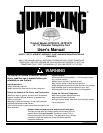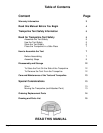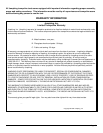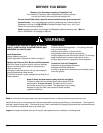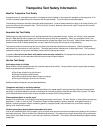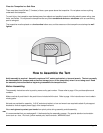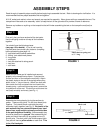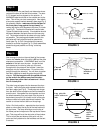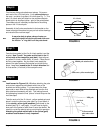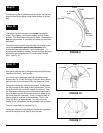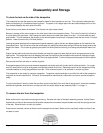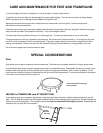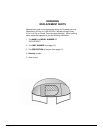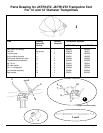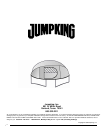
Page
5
Trampoline Tent Safety Information
Need for Trampoline Tent Safety
A trampoline tent is a recreational product. It is designed to be installed on the frame of a standard round trampoline 12 or
14 feet in diameter (depending on the model of the tent purchased). The tent makes an enclosed space.
The following information identifies important safety precautions. Some of these precautions apply to all kinds of tents, and
some are unique to this trampoline tent. The list is not all-inclusive, because a tent can be used in ways that this manual
cannot cover completely.
Assemble the Tent Safely
Detailed step-by-step instructions in this booklet describe how to assemble the tent. Adults, not children, must assemble
the tent. Wear work gloves to protect your hands from pinch points during assembly. When you assemble the tent, the
shock-corded fiberglass poles will be under some tension to keep the proper form of the tent. Keep children away from the
trampoline tent while it’s being assembled, and don’t allow them to play with tent parts during assembly.
To prevent pinches and cuts during tent use, the frame pad must be installed on the trampoline. (See the trampoline
manufacturer’s instructions on how to do this.) The frame pad must be installed prior to erecting the tent. The frame pad
reduces the chance of injury from accidental contact with the springs and frame.
In addition, the circle of tent fabric with plastic hooks must be installed on the trampoline mat (bed) as the tent floor.
It is flame resistant, and its use makes the entire tent enclosure flame resistant.
Use the Tent Safely
Adult supervision of children
When children use the trampoline tent they must be supervised by adults. Young children must be supervised constantly.
Adults must pay particular attention to —
✦The things children bring into the tent
✦Children’s activities inside the tent
✦Conditions inside the tent when children are using it
✦The way children get into and out of the tent
Additional details of safe tent use are described below.
Trampoline mat (bed) is not flame resistant
All tents are required to be made of flame-resistant fabric that meets specific test requirements. Because the trampoline
mat (bed) is not flame resistant, the tent must always be used with the flame-resistant tent fabric floor in place. The fabric
for the trampoline tent and tent floor is flame resistant and meets CPAI-84 requirements.
Flame-resistant fabric is not fire proof
Keep all fires and flames (including grills and barbecues) away from the tent. No fires, flames, or other ignition sources are
permitted in, under, or near the tent. Examples of these include cigarettes, lighters, matches, and lighted candles. In
addition, lanterns (propane, butane, kerosene, gasoline), catalytic heaters, canned-heat units, and similar heating or
lighting units should not be used.
Carbon monoxide poisoning hazard associated with tents
Just as with traditional tents, using heaters, grills, and other such products inside the trampoline tent poses a risk of carbon
monoxide poisoning. Carbon monoxide is odorless and colorless. It is produced as oxygen levels drop during combustion
from a fire or other heat sources in a tent that has insufficient ventillation. The carbon monoxide becomes trapped inside a
closed tent.



